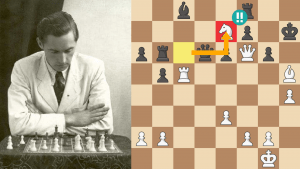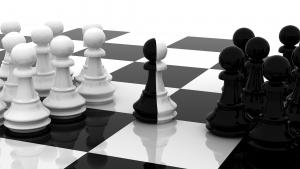Your Questions Answered 9/14
[Ed: this week, our daily columnists [may] have secretly traded columns. From this Sunday through Friday, read all the columns, and guess who wrote which. Mail your guesses to dpruess at chess.com. A couple prizes will be awarded at random to those with 6/6 correct answers.]
[This article was written by GM Julio Becerra]
Dear Mr. Silman,
I have three questions in regards to chess.
(1) Right now my rating is around 1685. I found that I have problem with chess calculation. I could not calculate lines as far as players below my rating. How can one improve their chess calculation? I found
selecting candidate moves very difficult (i.e. which one is better?)
(2) I have been playing the Sicilian Scheveningen defence for four years. However, I have faced many defeats when one sacrifice their bishop (lying on c4 or b3) on e6, or sacrifice one Knight for 2 pawns
on b5. Can you suggest ways to stop these sacrifices or ways to use these sacrifice to black's advantages?
(3) I also faced the Sicilian Prins variation (e4 c5 Nf3 d6 d4 cxd4 Nxd4 Nf6 f3!?). Then my opponent will set up a Maroczy bind and it is hard for me to get in d5 or b5 breaks. Do you have any suggestions on
how to counter the Prins variation?
Thanks for your time. Looking forward to the 4th edition of How to Reassess Your Chess.
Simon Ong
Simon:
1. According to my experience when I began playing chess, two of the books that helped me a lot in my calculation skill were 1001 Brilliant Ways to Checkmate and Win at Chess by Fred Reinfeld. There you can see all the typical ideas for the middle game. Also to get good at calculations there are other important things. Like be confident in what you see at the board. And one of the problems that we face a lot is the concentration during the game. After you finish those books, try to play games and to be focused on your position, and you will see how you can see more variations. When you play with players that have a lower rating than you, try to play your best all the time, because sometimes the players of low rating play even better than a Grand Master! Something that a lot of people do during the game to realize what move is better is to write down the move they think of first. Capablanca said that usually the first move you think of is the best!
2. The best way to stop the sacrifice of the bishop on “e6”, is to play Nbd7 before you develop the Bishop to “e7,” and then Nc5 taking the strong light-squared Bishop on “b3.” It is so important to do this before Be7, because then “g7” is unprotected and he can get three pawn for the piece and attack. About the sacrifice on “b5” frequently when White only has two Pawns for the piece it is not enough compensation. But this is dangerous when White also can take the “d6” Pawn like in the famous source game Bronstein-Najdorf, Buenos Aires 1954.
3. Although the opening selection almost always is a matter of personal preference, I can recommend in the Prins variation the follows sequence:
Jeremy:
I'm a beginning - intermediate level chess player. My rating on the tactics Trainer is around 1100 and chess mentor approximately 1500.
I see some of the tactics and going to the Chess mentor I see some of the moves, but not all. I can beat the beginning chess game pretty consistently to the point of no problem. I don't play that level anymore. But I can't get by the medium level. Good openings, but I lose it in the middle game.
I'm not sure the method of study to get better at chess. Is it just memorization of openings or patterns or is there something more intuitive?
I'm not sure how to proceed, can you suggest a method?
Regards,
Marc
Marc:
Many ways lead to Rome, my dear Marc, but in 90% of the cases in your level your principal work is: tactics, tactics and tactics! Forget about the openings, develop the pieces and play fundamental chess. The other 10% is basic chess endings! Then you will see how to quickly improve your chess. I can recommend to you CT-Art 3.0 electronic or book version, from Max Blok. This is among the bestsellers of Chess software!
Dear Mr. Silman,
In one tournament game I played recently, the game traded off to a rook vs. 2 bishops endgame, each with several pawns on each side so that material wise it was even. In general would you say the two bishops or the rook was more powerful in this type of endgame?
-Chess.com member Doomclaw
Doomclaw:
In this kind of endgame almost always the pair of Bishops (alias the little Queen!) is too much for a Rook alone! Of course, in chess the pawn structure and King security is very important. It is a bad business to trade two Bishops for a Rook. As an example, I want to show you one game played by me with this material constellation.
Hello,
Lazy people (or people with children like me without time) are playing the opening "Colle System" for white, its "universal system".
But what can I play for black? You now also a all-purpose opening for black for people without time?
Regards,
Dirk
Dear Dirk:
I cannot lie to you, my dear Dirk: with White it is easier to find a schema and play many moves automatically, but with Black your opponent can play e4, d4 or c4, therefore you need to look for something adequate to your style, because as Black there is no schema like White with the “Colle System.” Although I don’t recommend studying irregular openings, you should see some games with Spassky Black against Petrosian, from the World Championship of 1966. There Spassky played as Black something like this: …d6, e6, b6, g6, Bg7, Bb7, Nd7, Ne7, etc, etc, etc,…






